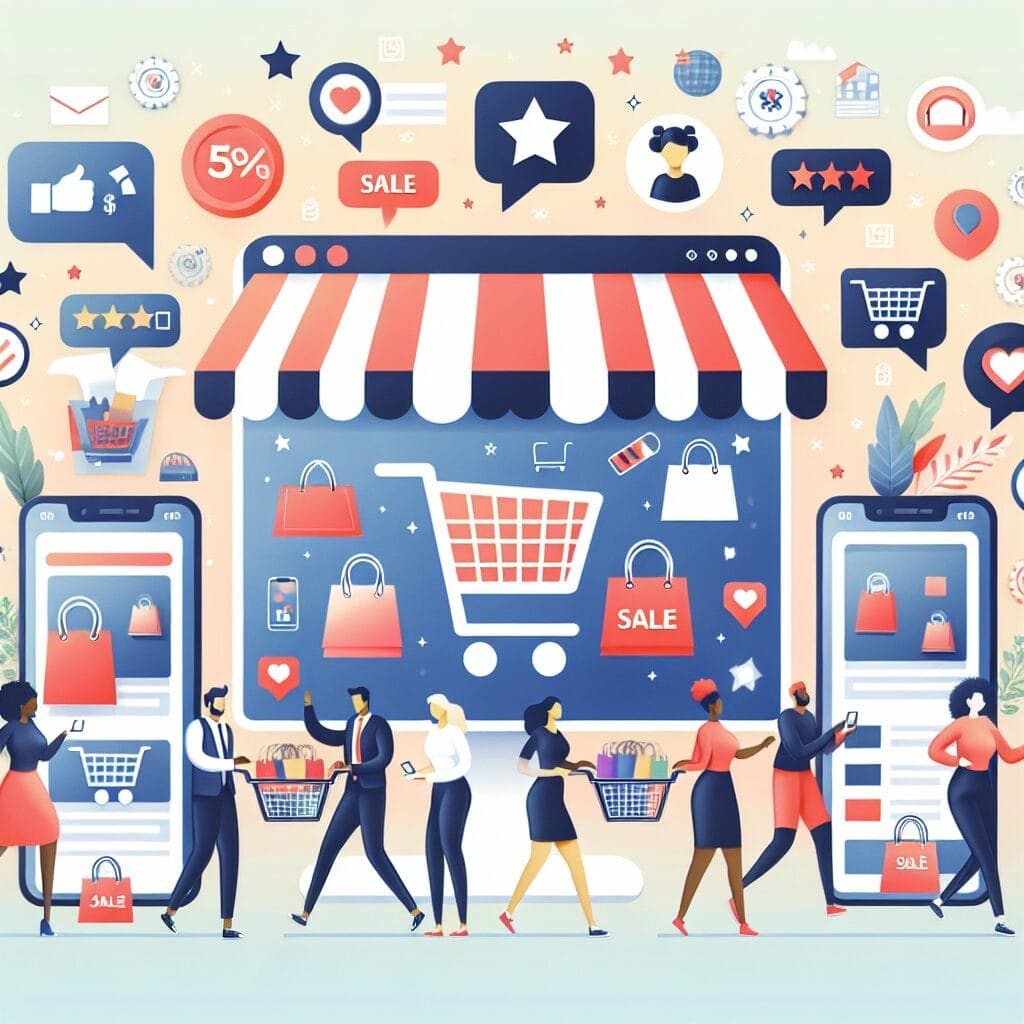Looking to make money online with your own online store? Well, you've come to the right place! In this article, we'll explore the top 10 must-have features that your online store absolutely needs in order to succeed. From a user-friendly interface to seamless payment options, these essential features will ensure that your customers have a smooth and enjoyable shopping experience. So, if you're ready to take your online store to the next level and make more money, keep reading!

User-Friendly Interface
In order to provide a seamless shopping experience to your customers, it is essential to have a user-friendly interface. This starts with clear navigation. When customers visit your online store, they should be able to easily find what they are looking for without any confusion or frustration. The navigation menu should be well-organized and intuitive, allowing customers to effortlessly browse through different categories and pages.
Another crucial element of a user-friendly interface is search functionality. Implementing a search bar on your online store enables customers to quickly and efficiently find the specific products they are interested in. This feature saves them time and enhances their overall shopping experience. It is important to ensure that the search functionality is accurate and delivers relevant results, making it easier for customers to find what they need.
Furthermore, an intuitive design is key to a user-friendly interface. Your online store should have a visually appealing layout that is easy on the eyes and enhances usability. It should be easy for customers to understand the layout and navigate through the different sections of your store. The design elements should be consistent across all pages, creating a cohesive and streamlined look.
Lastly, the checkout process should be smooth and hassle-free. Make sure the steps involved in completing a purchase are clear and straightforward. Provide clear instructions and options for payment and shipping. A user-friendly checkout process will help reduce abandoned carts and increase customer satisfaction.
Mobile Responsive Design
With the increasing use of smartphones and tablets for online shopping, having a mobile responsive design is crucial for the success of your online store. A mobile responsive design means that your website is optimized to adapt and function seamlessly on different screen sizes and devices. This ensures that customers can access your online store and have a positive experience regardless of the device they are using.
A mobile-friendly layout is an important aspect of mobile responsive design. The layout should be designed in such a way that it is easy to navigate and interact with on smaller screens. Text should be readable and images should be appropriately sized to fit different screen sizes without losing quality or clarity.
Responsive images and text are also important components of mobile responsive design. Images should automatically resize and adjust to fit the screen, ensuring that customers can view them without any distortion. Text should be legible and easily readable without the need for zooming or scrolling horizontally.
In addition to having a mobile responsive design, it is essential to optimize your website for mobile devices. This includes minimizing loading times, reducing large files, and ensuring fast and smooth navigation. By providing a seamless mobile experience, you can attract and retain customers who prefer shopping on their smartphones or tablets.
/5e_9XAS1GC0″ frameborder=”0″ allowfullscreen>
Product Catalog
A well-organized product catalog is essential for helping customers easily find and purchase the products they are interested in. Your online store should have categories that are logical and intuitive, making it easy for customers to navigate through different sections. Organize products into relevant categories and subcategories, ensuring that customers can quickly narrow down their search.
Detailed product descriptions are a vital part of a comprehensive product catalog. Include relevant information about each product, such as features, specifications, dimensions, and materials. This not only helps customers make informed purchasing decisions but also increases their confidence in your products.
High-quality product images are also crucial in showcasing your products effectively. Customers rely heavily on visuals when shopping online, so it is important to provide clear and visually appealing images that accurately represent your products. Invest in professional product photography or use high-resolution images to ensure the best possible presentation.
To further enhance the credibility of your products, include product reviews and ratings. This allows customers to read about the experiences of other buyers and make more informed decisions. Reviews and ratings also help build trust and establish your online store as a reliable source for quality products.
Secure Payment Options
Providing secure payment options is paramount for gaining customer trust and ensuring the safety of their personal and financial information. By offering multiple payment gateways, you allow customers to choose the method that they are most comfortable with. Popular payment gateways such as PayPal, Stripe, and Square provide secure and reliable options for online transactions.
SSL encryption is essential for encrypting data transmitted between your online store and customers' browsers. This ensures that sensitive information, such as credit card details, cannot be intercepted or accessed by unauthorized individuals. Implementing SSL encryption creates a secure environment for customers to make purchases with peace of mind.
PCI compliance is another important aspect of secure payment options. The Payment Card Industry Data Security Standard (PCI DSS) sets the guidelines for securely handling and storing cardholder data. By adhering to PCI compliance, you demonstrate your commitment to protecting customer data and complying with industry standards.
Convenient payment methods, such as digital wallets or buy now, pay later options, can also enhance the user experience and encourage more sales. Offering flexibility and choice in payment options makes it easier for customers to complete their purchases and increases the likelihood of them returning to your online store.

Fast Loading Speed
A fast loading speed is vital for providing a positive user experience and increasing customer satisfaction. Slow-loading websites can lead to high bounce rates and lower conversion rates. To ensure your online store loads quickly, optimize images by compressing them without compromising quality. This reduces the file size and allows images to load faster.
Optimizing code is another effective way to improve loading speed. Minify and compress HTML, CSS, and JavaScript files to reduce the overall file size. This helps reduce the time it takes for your online store to load and ensures a seamless browsing experience for your customers.
Implementing caching mechanisms is essential for improving loading speed. Caching stores certain elements of your website, such as images and scripts, in the user's browser. This allows subsequent page views to load faster since the browser doesn't have to retrieve all the elements from scratch.
Using a content delivery network (CDN) can also significantly improve loading speed, especially for customers located in different geographical locations. A CDN stores your website's files on servers distributed across different locations. When a customer accesses your online store, the files are delivered from the server location nearest to them, reducing latency and improving loading speed.
Minimizing the use of external scripts is important for faster loading speed. Scripts such as analytics tracking codes, social media widgets, or advertisement scripts can impact loading times. Evaluate the necessity of each script and remove any that are not essential for the functioning of your online store.
Customer Accounts
Offering customer accounts is a valuable feature that enhances the shopping experience and encourages customer loyalty. An easy registration process is key to encouraging customers to create accounts. Keep the registration process simple and straightforward, avoiding lengthy forms or unnecessary information.
Personalized account dashboards provide customers with a centralized hub to manage their purchases, track orders, and update their personal information. This allows customers to easily access and review their account details, ensuring a smooth and efficient experience.
Order history and tracking are essential features of customer accounts. Customers should be able to view their past orders, track the status of current orders, and access order details such as shipping information and tracking numbers. Providing this information gives customers peace of mind and keeps them informed throughout the entire purchasing process.
Saved payment and shipping details are convenient features that allow customers to streamline their future purchases. By securely storing their information, customers can complete transactions more efficiently without the need to re-enter their details each time. This feature not only saves time for customers but also increases the likelihood of repeat purchases.
Flexible Shipping Options
Offering flexible shipping options is crucial for catering to the diverse needs and preferences of your customers. Integrating multiple carriers allows customers to choose the shipping method that suits them best. Collaborate with popular shipping providers, such as UPS, FedEx, or DHL, to offer a wide range of shipping options.
Rate calculation based on weight or location is an important feature for accurate shipping costs. By integrating real-time rate calculation, customers can see the shipping cost for their specific order based on the weight of the items or their location. This transparency provides customers with valuable information for making purchasing decisions.
Real-time shipment tracking is a must-have feature that allows customers to monitor the progress of their orders from the moment they leave your warehouse until they arrive at their doorstep. This feature increases customer satisfaction by keeping them informed and alleviating any concerns about lost or delayed packages.
For customers who prefer a more hands-on approach, offering the option for local pickup is a great addition. This allows customers to pick up their orders from a designated location instead of having them shipped. Local pickup provides convenience for customers who may live in close proximity to the pickup location or prefer to avoid shipping fees.
Effective Search and Filter
An effective search and filter system is crucial for helping customers find the exact products they are looking for. Advanced search functionality allows customers to search for products based on specific criteria, such as brand, model, or features. Implementing a powerful search engine ensures accurate and relevant search results.
Filter options by price, size, color, and other attributes further enhance the search experience. Customers can narrow down their search results based on their preferences, making it easier to find the products that meet their specific requirements. This feature saves time and reduces frustration by eliminating irrelevant products from the search results.
Sorting options provide customers with additional flexibility in organizing the search results. Customers can sort products by price, relevance, popularity, or other criteria, allowing them to view the products in the order that suits their needs. This feature helps customers find the best products for their preferences while providing them with a personalized shopping experience.
Search autocomplete is a helpful feature that displays suggested search terms as customers start typing in the search bar. This not only helps customers find what they are looking for more quickly but also assists in more accurate search results. By providing real-time suggestions, customers can easily select the desired search term without having to type the entire query.
Social Media Integration
Integrating your online store with social media platforms is an effective way to expand your reach and engage with customers. Social sharing buttons allow customers to easily share products, promotions, or their overall experience with their social network. This increases the visibility of your online store and can attract new customers through word-of-mouth referrals.
Integration with popular social media platforms, such as Facebook, Instagram, Twitter, or Pinterest, allows customers to interact with your online store directly from their preferred social platforms. This enhances the shopping experience by providing seamless integration between social media and your online store.
Embedded social media feeds on your online store can provide real-time updates and showcase content from your social media platforms. Customers can see your latest posts, products, or promotions without leaving your online store. This feature not only keeps customers engaged but also serves as a visual representation of your brand's social media presence.
By offering social login/register options, you make it easier for customers to create accounts or log in using their existing social media profiles. This eliminates the need for customers to remember yet another username and password, simplifying the registration and login process. Social login/register options enhance convenience and can lead to higher conversion rates.
Responsive Customer Support
Providing responsive customer support is crucial for addressing customer inquiries, concerns, and issues in a timely and efficient manner. Live chat support allows customers to engage with support representatives in real-time, providing instant answers to their questions or assistance with any problems they may encounter. This feature enhances the overall customer experience, reduces frustration, and increases customer satisfaction.
In addition to live chat support, an email and ticketing system provides a platform for customers to submit inquiries or issues that may not require immediate attention. This allows for a more organized and structured approach to customer support, ensuring that no inquiries fall through the cracks.
FAQs (Frequently Asked Questions) and a knowledge base are valuable resources for customers seeking answers to common questions or troubleshooting assistance. By providing a comprehensive FAQ section and a knowledge base with step-by-step guides or tutorials, customers can find answers to their questions without the need to contact customer support. This not only saves time for both customers and support representatives but also empowers customers to find solutions on their own.
Lastly, quick response time is crucial for effective customer support. Customers expect timely responses to their inquiries and issues. By prioritizing customer support and ensuring quick response times, you demonstrate your commitment to customer satisfaction and build trust and loyalty with your customers.







